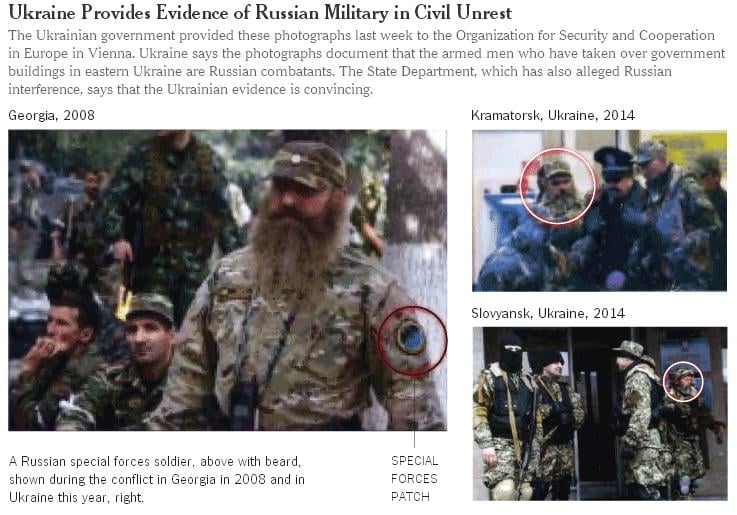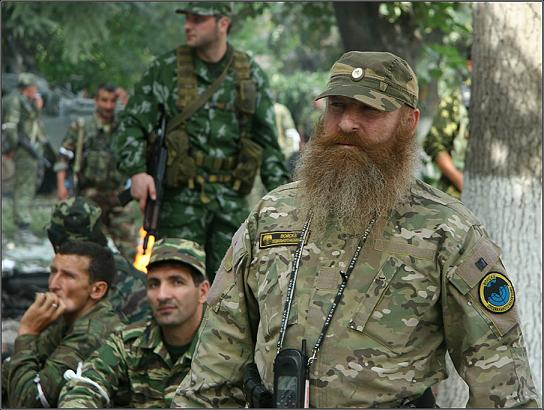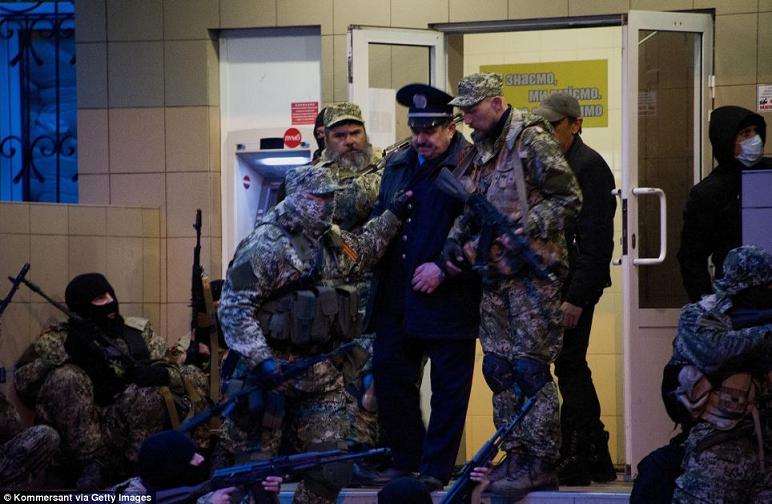By Alex Lantier
WSWS: April 23, 2014
A day after the New York Times published a front-page report purporting to show the involvement of Russian Special Forces in protests in east Ukraine, its report, titled “Photos Link Masked Men in East Ukraine to Russia,” has been exposed as a blatant fabrication.
The Times printed low-resolution pictures of fighters—allegedly wearing Russian insignia while in Georgia, and then later as protesters in east Ukraine—asserting they were the same men, thus proving the existence of an armed Russian intervention in Ukraine. It was based on a crude trick first noted by a commenter on a link posted on Reddit. The photos in the Times were down-sampled versions of higher-resolution images circulating online, which show that the men in the different pictures are in fact not the same.
Images from the New York Times with text and captions:
Original images posted on reddit:
It very rapidly became clear that the Times ’ claims to have proven that Russian soldiers were driving the east Ukraine protests against the pro-Western regime in Kiev were complete rubbish.
The BBC compared the high-resolution pictures of two bearded men theTimes falsely asserted were the same fighter. It concluded, “In the 2014 photos, the man’s greying beard appears to be black, while in Georgia six years ago, the slimmer-looking man shown has a reddish beard.”
It also noted that Russian Special Forces patches on the men’s uniforms, highlighted by the Times as proof that they are Russian troops, “can be bought on the Internet for less than $5.”
Asking whether the pictures “prove anything,” the BBC concluded: “It cannot be said for sure that they are actual Russian Special Forces, as the Ukrainians argue.”
In publishing the false allegations, the Times worked closely with the US government, which received the photos from the unelected pro-US regime in Kiev and “endorsed” them before passing them on. At a press briefing, however, US State Department spokeswoman Jen Psaki, whom the New York Times quoted in its article, indicated that the administration was well aware that the photos did not constitute proof of what was being claimed.
Pressed about whether she was certain the pictures showed individuals linked to Russia, Psaki replied: “What we see in these photos that have been, again, in international media, on Twitter, and publicly available, is that there are individuals who visibly appear to be tied to Russia. We’ve said that publicly a countless number of times. I will let you draw all the conclusions yourself as to whether these are individuals who look similar or not to other events.”
A journalist at the briefing objected to calling this “evidence,” and asked, “Do you think this is evidence that would stand up in a court of law?”
Psaki replied, “I don’t think it’s a legal—we’re not making a court-of-law case here. We’re just showing that this is photographic evidence that indicates the connection we’ve been talking about for weeks now.”
The journalist asked, “You think it is proof of connection, or it’s just—or you’re just alleging that it’s another sign of this?”
Psaki replied, “It’s another sign.”
In fact, the Times has worked to mislead its readers, uncritically presenting concocted photos delivered by its contacts in the State Department.
Washington, as it passed the pictures on to the Times, knew very well that they did not constitute evidence of anything, but were simply a new propaganda point supporting its as-yet unsubstantiated accusations of Russian involvement in Ukraine. The Obama administration relied on theTimes to publish the pictures, fanning the flames of the media campaign to denounce Russia, without doing any due diligence to check that its materials were accurate or that proved anything at all.
A decade ago, Times journalist Judith Miller was the conduit for broadcasting lies that Iraq had weapons of mass destruction (WMD), touching off a huge media campaign that set the stage for the US invasion of Iraq.
Today, the lies the Times is palming off as news could provoke a war with Russia, a nuclear-armed power. By fabricating evidence of Russian involvement in east Ukraine, the Times was providing political ammunition for calls in Ukraine and in the Western imperialist powers for a military crackdown against protests in east Ukraine, a region with a large Russian population. This could lead to a military intervention by Moscow in eastern Ukraine to break up the crackdown, and a clash between Russia and Ukraine drawing in the Western powers.
The Times ’ fabrications also served to obscure the fact that this conflict arose out of the decision of Washington and its European allies to topple Ukraine’s previous, Russian-aligned regime in a fascist-led putsch in February. The unelected pro-Western regime in Kiev has now encountered significant popular opposition in pro-Russian regions of eastern Ukraine. It is this aggressive policy of the Western powers that is driving the explosive standoff in eastern Ukraine.
The employees of the Times who were involved in producing this article, like Judith Miller before them, reflect the growing integration of the media and the state.
(read the full article at WSWS or Global Research)
—-
Alternative Free Press -fair use-


